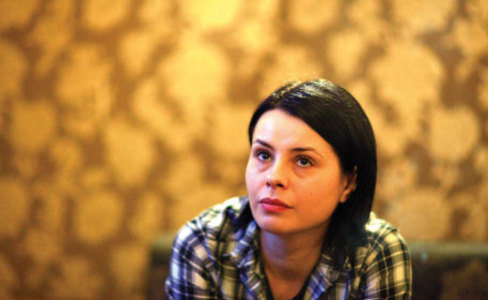about the production
Life in a smallish provincial Romanian town of Botosani is flowing at a quiet pace in the early 1980’s. The population has come to terms with the regime, many actively collaborate with the local centre of the Securitate – an organisation which, in contrast to other branches of industry or business, regularly pays people their salaries, and, moreover, applies methods and sophisticated technologies one cannot come across anywhere else. On festive occasions the local pioneers recite the verses of a local native Mihai Eminescu at his monument, poems that do not provoke in any way, on the contrary, seem to support the interpretation of classical works close to the regime. One autumn morning in 1981, however, there appeared several inscriptions on the walls of the buildings in the centre of the town. Slogans written in chalk declared: “No longer are we going to put up with the injustice in the country!” or “Freedom! We demand that human rights be respected!”
Securitate is in alert. Local people know that nothing good will come out of this. Fearing their own lives, they are prepared to do everything possible to find the author of the inscriptions as soon as possible and rid their town of his disturbing presence. In this story of antique dimensions, the whole polis turns away from the main protagonist. Only his devoted mother stands by his side up to his tragic end. Securitate is investigating. Very thoroughly. The file, nowadays deposited in the CNSAS (Council for the study of archives of the former Romanian secret police Securitate), had two parts. Panou (Fence, Board) and Elevul (Pupil). The first part of the file is an archive of measures and materials that should have led to the identification and detection of the author of the inscriptions. It is full of graphological and psychological references, criminological guesses, graphological tests of many selected people in the town and its environs. The second part of the file contains the materials about the author. It is entitled “Pupil”, because the author of the seditious inscriptions, well defining different topical social issues and urging the citizens to look for their remedy was, to the surprise of the Securitate and later also the citizens of the town, a 16-year-old secondary school pupil Mugur Calinescu. What was even more surprising was the fact that it was not only an innocent teenage provocation, but a well thought-out revolutionary act, by which Mugur wanted to address the wide masses.
He had no chance face to face with one of the most powerful secret police corps. The production by Gianina Cărbunariu is following a thrilling story of the young hero, a “street artist”, who, under the pressure of Securitate, is slowly ending up in isolation. The secret police set a large number of their people on Mugur – neighbours, teachers, classmates and applied a variety of psychological terror methods. Mugur was interrogated very regularly, in the beginning 3-4 times per week. There is no preserved record in the archive file about the course and content of these interrogations, which makes some people, like, e.g., Mugur’s mother, believe that the file is not complete. On the other hand, to what extent can such a record about someone’s life be complete? Who would profit, if all details associated with the case were not preserved? There are many more questions about Mugur’s story. At the age of 17 Mugur Calinescu died of leukaemia, after he had not been admitted to the university in Lasi as a result of Securitate and party bodies’ involvement and suffered all the intimidation and degradation. The reasons why he had contracted the illness have not been clarified yet. In addition to psychological problems, his illness could have been caused also by Securitate who is said to have used methods of inducing tumour illnesses by submitting radiation in food or drink. Nobody from the organisation has ever denied the use of these methods, which also Mugur Calinescu’s mother suspects the secret service of. Performing archives is a story of a young hero living at a time when innocent and highly ethical conduct (as seen today) could have cost people life. A story, some of whose protagonists are still alive and whose negative heroes are not only the top members of the secret police but mainly the non-functional community torn apart by ideology.
Ján Šimko
The origin of the production was initiated by the Divadelná Nitra Association within the project Parallel Lives – 20th Century through the Eyes of the Secret Police.
Romanian premiere: 20th September 2013.
creators
author and directed by Gianina Cărbunariu
set and costume design: Andrei Dinu
choreography: Florin Fieroiu
light design: Andu Dumitrescu
music: Bobo Burlăcianu
cast: Cătălina Mustață, Alexandru Potocean, Gabriel Răuță, Mihai Smarandache, Silvian Vâlcu
director

Gianina Cărbunariu (1977) studied direction at the National Theatre and Film University in Bucarest. She is one of the founders of the dramAcum drama group. In 2011 she designed production of ColectivA the project X mm out of Y km based on authentic documents of the secret police Securitate. Her plays Kebab (mady-baby.edu), Stop the Tempo, Asparagus, Fastforwardrewind were translated, published and staged in many European and Asian countries. The play Kebab (mady-baby.edu) was introduced at the Royal Court Theatre, London (2007), in the Munich Kammerspiele (2007) and in the Schaubühne Theatre, Berlin (2007). Gianina Cărbunariu’s projects are usually independent productions and many of them were staged at many European festivals (e.g. Neue Stücke aus Europa in Wiesbaden, the New Drama Festival in Bratislava, Kontakt – Toruń Festival, International Festival Divadelná Nitra).
Materials available
Video of the production: yes
Script of the production: SK, EN
If you are interested in these materials, write to archivy@nitrafest.sk
